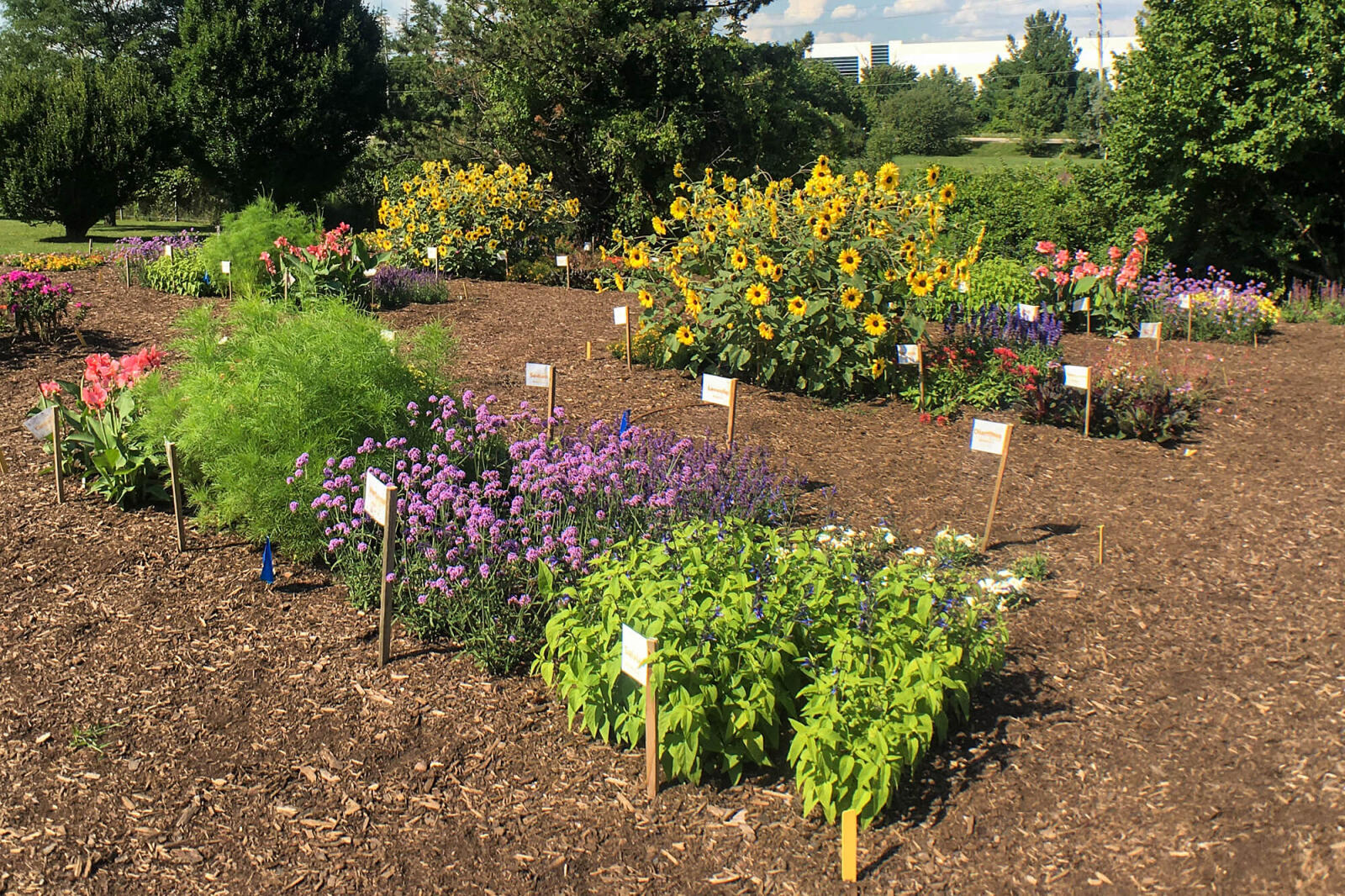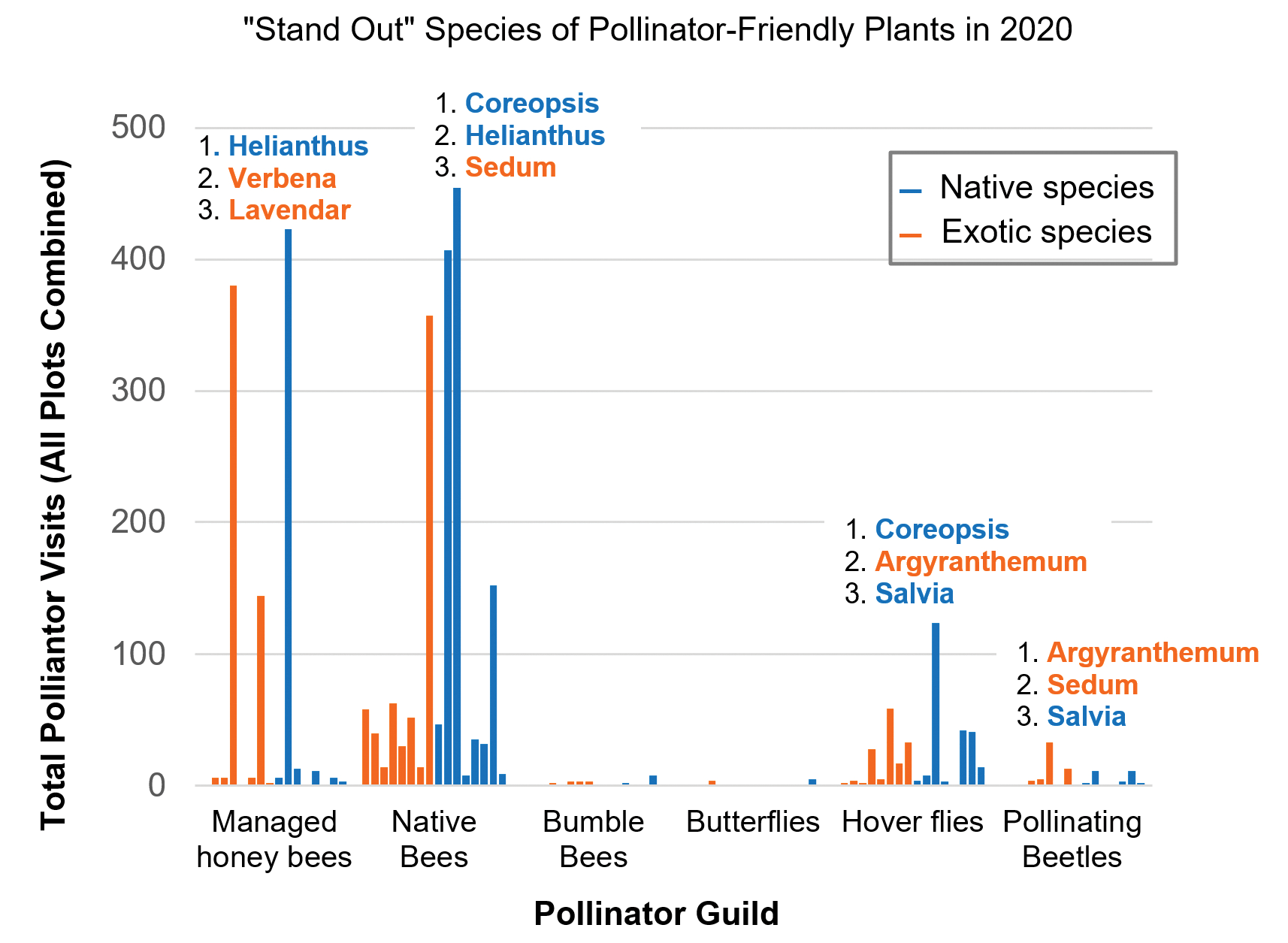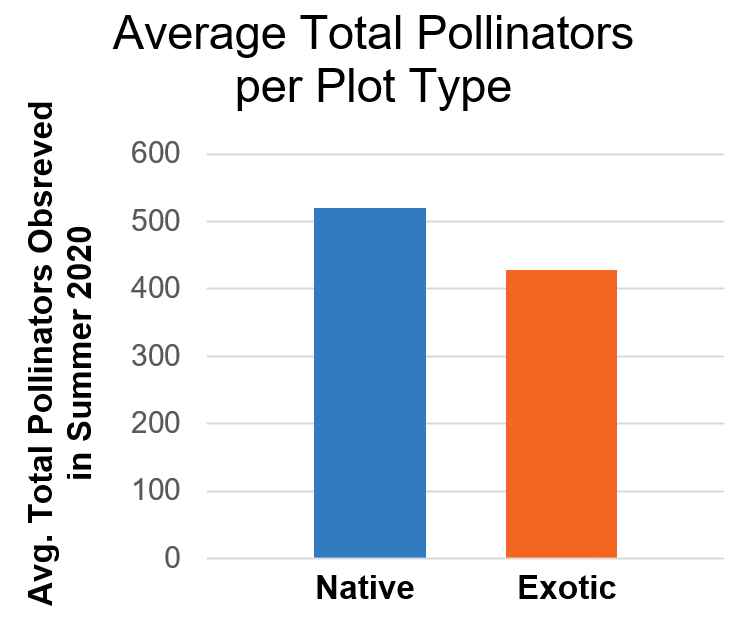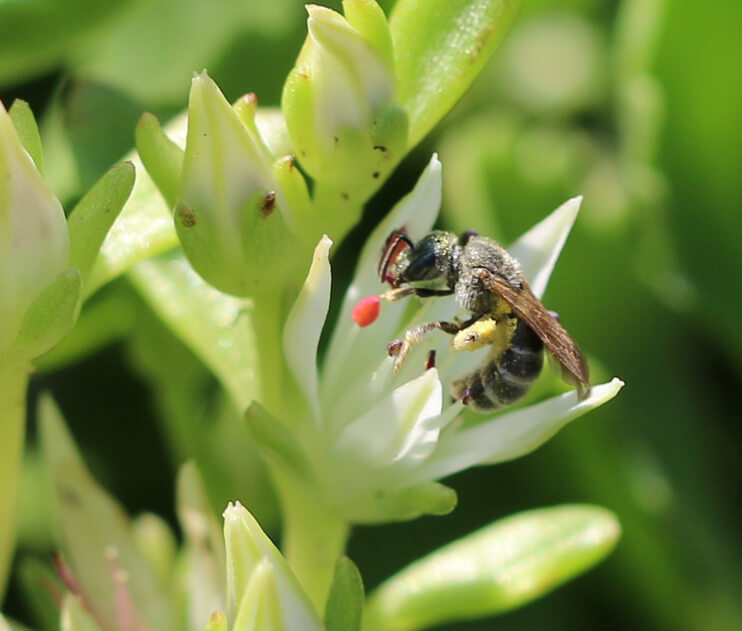March 8, 2021

The 2020 trial set up at the Landscape Ontario site. Plots of exotic ornamentals only (foreground) were compared to plots of native plants (background; with sunflowers). There were four plots per plant category (native or exotic) in a randomized design.
Helping homeowners help bees
It’s no secret there’s been a recent trend in gardening “with purpose.” Many homeowners and businesses want to contribute to local ecosystems by establishing pollinator gardens that provide food and shelter for bees, butterflies and other pollinator species.
So how do we help Ontario homeowners find the “right” plants? And, can we find pollinator-friendly plants that fit other criteria homeowners may have for a certain spot in their garden, such as annuals versus perennials, or short versus tall plants? Adding to the confusion, many resources solely promote the use of locally native plants for pollinator gardens. While native plant availability is increasing in the marketplace, the season-long ornamental value of many natives may be hampered by disease susceptibility and/or limited bloom period. Additionally, native plants can be difficult to source, and may also be considered too “wild” or “messy” to appeal to all homeowners.
In collaboration with Landscape Ontario, Ontario Ministry of Agriculture, Food and Rural Affairs (OMAFRA) and University of Guelph, researchers have been looking to help make planting pollinator garden for landscapers and homeowners easier, by way of studying how different plant species rate in their attractiveness to Ontario pollinators. One of our main goals was to determine if any popular “exotic” plants commonly grown by Ontario greenhouses (“exotic” meaning they originated outside of Canada and the continental U.S.) are attractive enough to pollinators to be considered reliable options for pollinator gardens in suburban areas.
Each of the last three years, we selected 10 exotic plant species typically grown by the greenhouse floriculture industry in Ontario, and directly compared them to 10 species of native plants. Specifically, we used what are referred to used “nativars” – cultivars of native plants that have been somewhat altered by the ornamental industry for aesthetics – to provide a more apples-to-apples comparison.
Our plots at the University of Guelph were done with individual plant species in test strips, but in 2020, we were able to plant entire beds of either all exotic or all native plants at the Landscape Ontario site in Milton, Ont., to get a better feel for how these would look and appeal to homeowners.
Here, each ornamental species was planted at densities that would best fill up each plot when plants reached full size (e.g. nine dianthus per square metre, but only five plants for a bigger species like lavender). Factors such as height, seasonality, colour and flower type were all considered in plant selection to achieve a good mix, though much of our selection was based off of which plants successfully attracted pollinators in the test strips at the Guelph Turfgrass Institute (GTI) from 2016 to 2018. Students then watched the plots for 30 minutes at a time and counted the pollinators that came to visit, making note of which plant was visited. Pollinators were only counted if they landed on a flower and stayed to gather nectar or pollen.
Overall, the students logged over 70 hours of observations and counted about 3,000 pollinators this past summer! So, what did all this work reveal?
Looking at our data from 2020, garden plots made up entirely of native plants attracted slightly more pollinators overall, but this difference wasn’t significant (Table 1). If a homeowner was standing next to a home garden of this size (2 x 4 m), they could expect to observe around 58 pollinators per hour on any given day if they had all native plants, versus 48 pollinators in an all-exotic garden – hardly a difference they would notice!
If we look at the data more closely, we can see why this is. Despite the accepted thinking that native plants are generally the better choice for pollinators, we can see from the graph (Table 2) that some species did well (tall blue bars), while other native species weren’t very attracted at all (small blue bars). For example, Coreopsis received over 900 pollinator visits in our 2020 trial, but other native plant species, like Phlox and Guara weren’t very attractive to pollinators (at least those found in Ontario), with fewer than 90 total pollinators each.
 Table 2. Pollinator visits broken down by pollinator guild (or group). Blue bars indicate native plant species; orange bars, exotic plant species. Plant species that received the most visits by any one pollinator guild are listed.
Table 2. Pollinator visits broken down by pollinator guild (or group). Blue bars indicate native plant species; orange bars, exotic plant species. Plant species that received the most visits by any one pollinator guild are listed.
In both plant categories (native or exotic), plant species with the highest total numbers of pollinator visits tended to attract mostly managed honey bees, native bee species, or both (Table 3). While visits from lots of bees is great (we love bees!), the total number of pollinators isn’t the only thing we looked at when it comes to a successful pollinator garden. To play a bigger role in helping all pollinators that have few food sources in urban areas, pollinator gardens should also support as many different groups (or “guilds”) of pollinators as they can.
Table 3. “Stand-out” plant species that attracted the most pollinators in the three years of trials in southern Ontario. Plants that attract high numbers of native bees are indicated in bold, as they are often of most interest to consumers. Plants are roughly ranked from most to least attractive by origin.
For example, although some plants like Argyranthemum didn’t attract many bees in our 2020 trial, they did draw higher numbers of both hover flies and pollinating beetles than the other plants tested. This makes them an important contender as part of the type of garden that supports both abundance and diversity of pollinators.
Taken together, our data suggests that the best pollinator garden would likely make use of a mix of species of both native and exotic, which is why we’ve compiled this list of stand-out performers from the species and cultivars we tested in our three years of research. Although it’s not exhaustive, this list is a good place to start with clients, as it allows homeowners to customize their garden with a mix of natives, exotics, annuals and perennials.
As a note of caution, our data also show — not surprisingly — that variety can have a big effect on pollinator attractiveness. Changes to the aesthetics of a plant species during breeding can also change things about the plant that pollinators like, such as volatiles, amount of pollen or nectar, or the colour the insect sees. This information is not new, as previous publications have shown that pollinator attractiveness can vary between varieties by as much as 10 times. This may partially explain why some of our plant choices that should have been successful didn’t perform well at all (e.g. nativars such as Guara lindheimeri ‘Variegata Rose’, Phlox paniculata ‘Purple Improved’, Penstemon digitalis ‘Dakota Burgundy’ and Heuchera villosa ‘Pinot Noir’).
To overcome such issues between varieties, landscapers should keep their eye out for specific cultivar recommendations, such as the ones included here. But another solution is just to recommend that homeowners plant as many pollinator friendly plants as possible — native and exotic — to hedge their bets.
Dr. Sarah Jandricic is the Greenhouse Floriculture IPM Specialist for OMAFRA. Famke Alberts is a fourth year student at McMaster University and was part of the Summer Employment Opportunity program at OMAFRA in 2020. Rodger Tschanz is the Trial Garden Manager at the University of Guelph, and Dr. Al Sullivan is Professor Emeritus at U of G. Land was provided by the University of Guelph in 2016 and 2018, and by Landscape Ontario in 2020.
So how do we help Ontario homeowners find the “right” plants? And, can we find pollinator-friendly plants that fit other criteria homeowners may have for a certain spot in their garden, such as annuals versus perennials, or short versus tall plants? Adding to the confusion, many resources solely promote the use of locally native plants for pollinator gardens. While native plant availability is increasing in the marketplace, the season-long ornamental value of many natives may be hampered by disease susceptibility and/or limited bloom period. Additionally, native plants can be difficult to source, and may also be considered too “wild” or “messy” to appeal to all homeowners.
In collaboration with Landscape Ontario, Ontario Ministry of Agriculture, Food and Rural Affairs (OMAFRA) and University of Guelph, researchers have been looking to help make planting pollinator garden for landscapers and homeowners easier, by way of studying how different plant species rate in their attractiveness to Ontario pollinators. One of our main goals was to determine if any popular “exotic” plants commonly grown by Ontario greenhouses (“exotic” meaning they originated outside of Canada and the continental U.S.) are attractive enough to pollinators to be considered reliable options for pollinator gardens in suburban areas.
Each of the last three years, we selected 10 exotic plant species typically grown by the greenhouse floriculture industry in Ontario, and directly compared them to 10 species of native plants. Specifically, we used what are referred to used “nativars” – cultivars of native plants that have been somewhat altered by the ornamental industry for aesthetics – to provide a more apples-to-apples comparison.
Our plots at the University of Guelph were done with individual plant species in test strips, but in 2020, we were able to plant entire beds of either all exotic or all native plants at the Landscape Ontario site in Milton, Ont., to get a better feel for how these would look and appeal to homeowners.
Here, each ornamental species was planted at densities that would best fill up each plot when plants reached full size (e.g. nine dianthus per square metre, but only five plants for a bigger species like lavender). Factors such as height, seasonality, colour and flower type were all considered in plant selection to achieve a good mix, though much of our selection was based off of which plants successfully attracted pollinators in the test strips at the Guelph Turfgrass Institute (GTI) from 2016 to 2018. Students then watched the plots for 30 minutes at a time and counted the pollinators that came to visit, making note of which plant was visited. Pollinators were only counted if they landed on a flower and stayed to gather nectar or pollen.
Overall, the students logged over 70 hours of observations and counted about 3,000 pollinators this past summer! So, what did all this work reveal?
If we look at the data more closely, we can see why this is. Despite the accepted thinking that native plants are generally the better choice for pollinators, we can see from the graph (Table 2) that some species did well (tall blue bars), while other native species weren’t very attracted at all (small blue bars). For example, Coreopsis received over 900 pollinator visits in our 2020 trial, but other native plant species, like Phlox and Guara weren’t very attractive to pollinators (at least those found in Ontario), with fewer than 90 total pollinators each.
 Table 2. Pollinator visits broken down by pollinator guild (or group). Blue bars indicate native plant species; orange bars, exotic plant species. Plant species that received the most visits by any one pollinator guild are listed.
Table 2. Pollinator visits broken down by pollinator guild (or group). Blue bars indicate native plant species; orange bars, exotic plant species. Plant species that received the most visits by any one pollinator guild are listed.
In both plant categories (native or exotic), plant species with the highest total numbers of pollinator visits tended to attract mostly managed honey bees, native bee species, or both (Table 3). While visits from lots of bees is great (we love bees!), the total number of pollinators isn’t the only thing we looked at when it comes to a successful pollinator garden. To play a bigger role in helping all pollinators that have few food sources in urban areas, pollinator gardens should also support as many different groups (or “guilds”) of pollinators as they can.
| ORIGIN | SEASONALITY | PLANT SPECIES | COMMON NAME | CULTIVAR(S) | POLLINATORS ATTRACTED |
| Exotic | Perennial | Cosmos bipinnatus | Cosmos | 'Candy Strip' | Honeybees, native bees |
| Exotic | Annual | Verbena bonariensis | Tall Verbena | ‘Meteor Shower’ | Honeybees, native bees, hoverflies, butterflies and moths |
| Exotic | Perennial | Sedum spurium | Stonecrop | 'Summer Snow' | Native bees, hoverflies |
| Exotic | Annual | Canna generalis | Canna Lilly | ‘Toucan Coral’, ‘Toucan Yellow’ | Wasps, native bees |
| Exotic | Annual | Argyranthemum frutecens | Marguerite Daisy | ‘White Butterfly’ | Hoverflies, native bees, pollinating beetles |
| Exotic | Perennial | Dianthus chinensis x barbatus | Pinks | 'Floral Pink' | Butterflies and moths, hoverflies |
| Exotic | Perennial | Lavandula angustifolia | Lavender | ‘SuperBlue’ | Honeybees, bumblebees, carpenter bees |
| Exotic | Annual | Pentas lanceolata | Starflower | ‘Lucky Star Raspberry’ | Pollinating beetles |
| Native | Perennial | Helianthus hybrida | Sunflower | ‘Sunfinity’ | Honeybees, native bees |
| Native | Perennial | Echinacea purpurea | Coneflower | ‘Eccentric Yellow’, ‘Green Twister’, ‘Summer Sky’ | Honeybees, wasps, butterflies, beeflies, pollinating beetles |
| Native | Perennial | Heliopsis helianthoides | Ox eye | var. scabra ‘Burning Hearts’ | Honey bees, native bees, hoverflies bumblebees, bee flies |
| Native | Perennial | Rudebeckia occidentalis | Western Coneflower | ‘Green Wizard’ | Bumblebees, pollinating beetles |
| Native | Perennial | Coreopsis verticillata | Whorled Tickseed | 'Corleone Red and Yellow' | Native bees, hoverflies, bee flies, Pollinating beetles |
| Native | Perennial | Coreopsis grandiflora | Large-flowered Tickseed | 'Double the Sun' | Butterflies, beeflies, hoverflies |
| Native | Perennial | Monarda hybrid | Bergamot, Bee Balm | 'Leading Lady Plum' | Bumblebees, hoverflies |
| Native | Perennial | Salvia farinacea | Mealycup Sage | 'Unplugged So Blue' | Native bees, hoverflies, bumble bees |
For example, although some plants like Argyranthemum didn’t attract many bees in our 2020 trial, they did draw higher numbers of both hover flies and pollinating beetles than the other plants tested. This makes them an important contender as part of the type of garden that supports both abundance and diversity of pollinators.
Taken together, our data suggests that the best pollinator garden would likely make use of a mix of species of both native and exotic, which is why we’ve compiled this list of stand-out performers from the species and cultivars we tested in our three years of research. Although it’s not exhaustive, this list is a good place to start with clients, as it allows homeowners to customize their garden with a mix of natives, exotics, annuals and perennials.
As a note of caution, our data also show — not surprisingly — that variety can have a big effect on pollinator attractiveness. Changes to the aesthetics of a plant species during breeding can also change things about the plant that pollinators like, such as volatiles, amount of pollen or nectar, or the colour the insect sees. This information is not new, as previous publications have shown that pollinator attractiveness can vary between varieties by as much as 10 times. This may partially explain why some of our plant choices that should have been successful didn’t perform well at all (e.g. nativars such as Guara lindheimeri ‘Variegata Rose’, Phlox paniculata ‘Purple Improved’, Penstemon digitalis ‘Dakota Burgundy’ and Heuchera villosa ‘Pinot Noir’).
To overcome such issues between varieties, landscapers should keep their eye out for specific cultivar recommendations, such as the ones included here. But another solution is just to recommend that homeowners plant as many pollinator friendly plants as possible — native and exotic — to hedge their bets.
Dr. Sarah Jandricic is the Greenhouse Floriculture IPM Specialist for OMAFRA. Famke Alberts is a fourth year student at McMaster University and was part of the Summer Employment Opportunity program at OMAFRA in 2020. Rodger Tschanz is the Trial Garden Manager at the University of Guelph, and Dr. Al Sullivan is Professor Emeritus at U of G. Land was provided by the University of Guelph in 2016 and 2018, and by Landscape Ontario in 2020.

